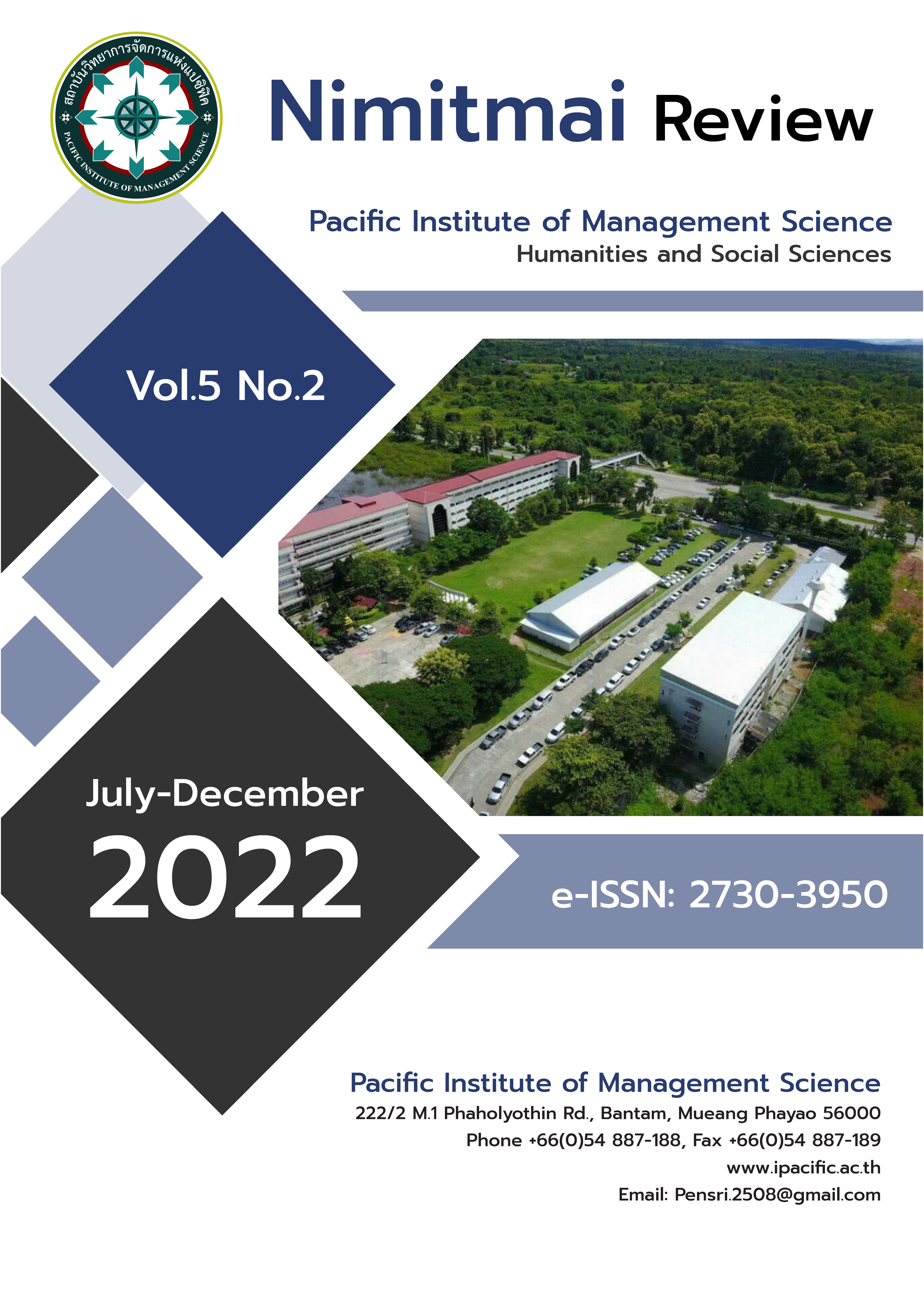Factors Affecting Being the Learning Organization of the Private Higher Education Institutions: A Case Study of Northern College
Keywords:
Factors, Learning Organization, the Private Higher Education InstitutionsAbstract
The purposes of this research are to study the relationship between predictor variables and being a learning organization and study the predictor variables that affect being a learning organization as well as finding the best factors that affect being a learning organization. Moreover, this research also studies the guidelines on how to be the learning organization of the private higher education institutions: a case study of Northern College. Samples used in this research were 92 personnel of Northern College. The research instrument was a 5-level rating scale questionnaire. The statistics used in the data analysis were: frequency, percentage, the Pearson correlation coefficient was used to analyze the correlation coefficient, standard regression analysis, stepwise multiple regression analysis, and content analysis.
The research results showed as follows:
1. The relationship between predictor variables and being a learning organization of the private higher education institutions: a case study of Northern College was found out that the correlation coefficient between the 7 variables, total 21 values, had 21 positive values with a statistically significant level of 0.05. The correlation coefficient had the range between 0.214 and 0.829. The highest intraclass correlation coefficient between the independent variables was the organizational climate aspect (X3) and the knowledge management aspect (X5) (r = 0.829).
2. The predictor variables influenced a learning organization of the private higher education institutions: a case study of Northern College was found out that there were 2 values with a statistically significant level of 0.05, which were the learning aspect (X6) that had a positive influence with a size of 0.066 and the management aspect (X2) that had a positive influence with a size of 0.059. These can be written as the prediction equation for being a learning organization of the private higher education institutions: a case study of Northern College in the form of raw scores and standard scores, respectively, as follows:
Y = 3.852 + 0.066X6 + 0.059X2
ZY = 0.303Z6 + 0.347Z2
3. The best predictor variable that affected being a learning organization of the private higher education institutions: a case study of Northern College was found out that there were 2 values with a statistically significant level of 0.05, which were the learning aspect (X6) that had a positive influence with a size of 0.058 and the management aspect (X2) that had a positive influence with a size of 0.048. These can be written as the prediction equation for being a learning organization of the private higher education institutions: a case study of Northern College in the form of raw scores and standard scores, respectively, as follows:
Y = 3.908 + 0.058X6 + 0.048X2
ZY = 0.266Z6 + 0.285Z2
4. The guidelines for being a learning organization of the private higher education institutions: a case study of Northern College due to the need to be developed are included of the 3 aspects, which are the use of technology aspect, the cognitive style aspect and the development of the team learning aspect.
References
Akaraborworn, C. (2011). Develop People on Sustainability. Bangkok: Tao. (In Thai).
Boonyanuwat, R. (2018). The Way to Survive and the Choice for the Private Higher Education Institutions. (Online). Retrieved on October 6th 2021 https://www.matichon.co.th/education/news_787866. (In Thai).
Brandt, R. (2003). Is this School a Learning Organization? 10 Ways to Tell. Journal of Staff Development, 24 (1), 10-16.
Certo, S. C. (2000). Modern Management. (8th ed.). Upper Saddle River, New Jersey: Prentice Hall.
Cummings, T. G. & Worley, C. G. (2009). Organization Development & Change. (9th ed.) Ohio: South-Western Cengage Learning.
De Simone, R. L., Werner, J. M. & Harris, D. M. (2002). Human Resource Development. (3rd ed.) Orlando: Harcourt College Publishers.
Estrada, N. (2009). Exploring Perception of a Learning Organization by RNs and EBP Beliefs and Implementation in the Acute Care Setting, Journal compilation, Fourth
Hislop, D. (2009). Knowledge Management. New York: Oxford University.
Jansook, N. (2013). A Model and Strategies for Developing Learning Organization of Nursing College. Doctor of Philosophy Thesis, Chulalongkorn University. (In Thai).
Kavanage, M. L., & Thite, M. (2009). Human Resource Information Systems. California:
Piyamatya, C. (2013). Factors Affecting to Learning Organization of the Royal Thai Army’s
Marquardt, M. J. (1996). Building the Learning Organization: A Systems Approach to Quantum Improvement & Global Success. New York: McGraw – Hill.
Marquardt, M. J. & Reynolds, A. (1994). The Global Learning Organization: Gaining Competitive Advantage through Continuous Learning. Burr Ridge, IL: Irwin.
Makasiranondh, W. (2010). From Learning Organization to Organizational Intelligence. (4th ed.). Bangkok: Expernet. (In Thai).
Moskowitz, M. (2008). A Practical Guide to Training and Development. San Francisco, CA: Pfeiffer.
Naweekarn, S. & Rumakom, P. (1997). Organization, Theory and Behaviors. Bangkok: Duangkamon. (In Thai).
Niyomsrisomsak, S. (2012). Developing Schools into Learning Organizations: Concrete Practice Guidelines. Academic Services Journal, year 23, Vol. 1, 17-30. (In Thai).
Noknoi, C. et al. (2009). Various Perspectives on Knowledge Management and the Creation of a Learning Organization. Bangkok: S. Asia Press. (In Thai).
Piboonwong, T. (2016). The Development of Learning Organization of the Government Savings Bank Regional Office 14. Master of Business Administration Thesis, Public Management, Graduate School, Burapha University.
Saiyot, L. and Saiyot, A. (1997). Statistical Methods in Education. Bangkok: Suweeriyasan. (In Thai).
Sanguanwongwan, W. (2008). Management and Organizational Behavior. Bangkok: Pearson Education Indochina. (In Thai). Quarter, 200-209.SAGE Publication.
Senge, P. M. (1990). The Fifth Discipline: The Art and Practice of the Learning Organization. London: Century Press.
Swart, J., Mann, C., Brown, S., & Price, A. (2009). Human Resource Development. Oxford: Butterworth Heinemann.
Watkins, K. E. & Marsick, V. J. (1993). Sculpting the Learning Organization: Lessons in the Art and Science of Systemic Change. San Francisco, Calif.: Jossey–Bass.
Yawirat, N. (2003). Modern Management. Bangkok: Central Express. (In Thai).
Downloads
Published
How to Cite
Issue
Section
License
Copyright (c) 2022 Nimitmai Review Journal

This work is licensed under a Creative Commons Attribution-NonCommercial-NoDerivatives 4.0 International License.


